Enjoy Gaudi and Moorish Architecture in Spain in 2017
(Part 1 of 2)
(Travel Story Series @ Hon Too Fang 2021)
We last visited Spain in 2010, on a group tour. In Nov 2017, together with another couple, we revisited Spain on the free-n-easy style. Just over 2 weeks. On our own itinerary. This is a straight forward travelogue in 2 parts.
A – Introducing Spain
Spain is a country about 1.5 times bigger than Malaysia, with some 46 million people. Politically it is a parliamentary democracy with a constitutional monarchy, similar to Malaysia. Administratively it is made up of 17 autonomous communities, each evolved from an historical nationality. A union of 17 former kingdoms, or queendoms. She enjoyed her Golden Age around the 15th to 17th centuries, when her powerful armada ruled the World. The Iberian Peninsula was occupied by the Muslim Moors during the Middle Ages. The Moors are Muslims from northern Africa, mainly the Berber people.
In religion, 61% of the people declare themselves to be Catholics, 3% followers of other religions like Muslims and Protestants, and 35% no religion. For those declared as Catholics, only about 20% go to church regularly and 60% hardly.
We went to 6 cities: Barcelona, Madrid, Cordoba, Malaga, Seville and Granada, in just over 2 weeks. Our story will follow this sequence.
B - Barcelona
Barcelona is the capital and largest city in the community of Catalonia and Spain's second largest city. City population: 1.6 million. It is the tourist capital of Spain, welcoming some 30 million visitors in 2016. Tourism contributes about 12% of the city's GDP.
The Legacy of Antoni Gaudi
To us Barcelona is about Gaudi (1852-1926), the great architect who worked during the Modernism (Art Nouveau) period but really became famous for his unique and highly individualistic designs beyond the scope of Modernism. He used a lot of paraboloids and hyperboloids in his design, irregular and intricate. In material he loved mosaic and glass.
He has designed about 20 projects, mostly in Spain, Barcelona in particular. 7 of his projects are grouped together and listed as a UNESCO World Heritage Site with the heading "Works of Antoni Gaudi". We visited 3 of these on this trip: Casa Batllo, Park Guell and Sagrada Familia.
This private house, several stories high, was originally built for a middle class family and in 1904 Gaudi was commissioned to refurbish the building. Gaudi replaced the original facade with a work in glass and stone. The facade wall was made to curve and bend like a wave, and covered with a mosaic of coloured glass and ceramic fragments. The top of the building looks like the back of a dragon, with scales and a spine which seem to change colour as one looks at it from different angles. Pillars, balconies, etc, are made in fanciful shapes and material.
The interior is just as remarkable: a staircase banister which looks like the spine of an animal; a room is decorated to look like it is under water, etc.
(Note in 2021: We paid about RM 100 each for the entrance fee, queued for an hour to go in. The original house owner would never imagine he has left a gold mine to his descendants.)
Park Guell
Park Guell is a surrealistic public park, beautifully landscaped and features architectural elements in Gaudí's signature style. Built from 1900 to 1914, it features a breath-taking entrance gate, winding staircases and spectacular terraces with several fountains covered in bright ceramic mosaics, a colonnaded hall, viaducts, etc. Gaudi stayed in a house here for 20 years, now a museum.
The most impressive park entrance structure, with details of the wall, window and gate. Most awesome. The multitude of symbols points out that this park is Paradise.
Immediately after the entrance gate are the office building and the caretaker’s lodge. Shown 2 views of the lodge, a “more” normal building.
A general view of the central terrace, with 4 flights of stairs, showing the curved side walls tiled with ceramic mosaics of many designs.
The most photographed objects are the fountains on the terrace, especially the pair of the dragon and the serpent at the top of the terrace, shown with CL, and the crowd around it. Security personnel is needed to maintain the order to queue, pose and shoot.
At the top of the terrace is the colonnaded hypostyle hall which is supposed to be the market place. It has a forest of Doric columns from classical Greece. There are 4 colourful rosettes on the ceiling to represent the 4 seasons.
On top of the hypostyle hall is an open space adorned with curved and tiled benches. Shown with our travel-mates KS and CL.
And lastly a viaduct. Rough and earthly, a strong contrast with the smooth tiled elements in other places. Only the genius Gaudi could dare to do that.
Sagrada Familia
This Basilica of the Holy Family is a Catholic church, Gaudi's finest masterpiece. Construction began in 1882 under a different architect. Gaudi took over a year later and changed the design significantly. It became his life work. Gaudi was a devout Catholic and single. He worked on this project for free. And in his last 15 years or so, he was full time on this project. Gaudi died in 1926 and he lived to see only a fraction of the structures completed.
The building process dragged on slowly through the wars until the 1950s when construction began in earnest. At present there are 8 completed towers and two facades. The church plans called for 18 towers, 3 facades and an area to accommodate 13,000 worshipers.
Shown the building complex viewed from the north-west, and some details of nearly completed buildings. The 2nd photo shows the towers above the Passion Façade, the cone-like structure in the 3rd photo is the Sacristy. Then the typical façade of the Apse in the 4th photo and details of the top part of 1 of the 8 Apostles' Towers, 110 m tall. Lastly towers and cranes vying for space in the blue sky.
The Nativity Facade
Two of the 3 facades are completed. The east-facing Nativity Facade (birth of Christ) was completed around 1932. It has a myriad of "traditional" sculptures, the main one above the Nativity Portico is the group called "The Tree of Life". In this group is the Holy Family (Joseph, Mary and infant Jesus) located immediately above the doorway. Also the 3 kneeling wise men and 2 angels on harps.
Passion Facade
Construction of the Passion Facade (the last days of Christ) was started in 1954 and essentially completed in 2017 minus minor touches of the sculptures. Here the sculptures are exceptionally simple and bare, without ornamentation, evoking the suffering of Jesus Christ at the Passion. The main figures were sculptured by Josep Maria Subirachs in 1990 based on Gaudi's drawings. Shown the main portico and a scene depicting the Crucifixion of Jesus. Then the Flagellation of Jesus (tied and whipped), and the Kiss of Judas with the Magic Square where all the columns and rows add up to 33, the age of Jesus when he died.
Interior
If you are fascinated by the exterior, you will be stunned by the interior. It is a forest of columns branching out at the top to support the parabolic vaults, a kind of tree top envisaged by Gaudi. Light easily filtered through bestowing the religious space with spiritual illumination. The 5th photo shows a part of the wall and the last photo shows the umbrella or canopy above the high altar which is a crucifix. Only Gaudi!
And lastly some stained glass windows, more traditional and familiar.
The church hopes that construction will be completed by 2026, the centennial of Gaudi's death. Funding is provided by the public and entrance ticket sales.
(Note in 2021: With the pandemic, the target is unlikely to be met. Just wonder: if they have instead employed Chinese contractors 20 years ago it should be completed by now!)
La Rambla
La Rambla is the tree-lined main pedestrian street in Barcelona, frequented by all tourists and pick-pockets. At one end is Plaza de Cataluna, a huge square with several groups of monuments and sculptures. Shown the nude woman by Josep Clara and a political monument in honour of Francesc Macia by Josep Maria Subirachs, who did the sculptures of the Passion Façade of the Basilica of the Holy Family we just covered.
On this busy street are shops, well decorated buildings, pavement cafes, souvenir kiosks, and tourists, performing artists, etc. The double decker tourist buses run along the service road too though the central main street is traffic free. The La Boqueria is a famous market along the La Rambla.
Columbus Monument and Rambla de Mar
At the other end of the 1.2 km street is the Columbus Monument constructed in 1888 to honour Christopher Columbus. And next to it is Rambla de Mar, a pier with a shopping complex.
Gothic Quarter
The Gothic Quarter is a popular tourist district, the oldest part in the city with churches, squares and government offices. Shown the iconic bridge linking 2 buildings across Carrer del Bisbe or the Bishop’s Street, and the heavily decorated façade of a nearby building. One of the main squares here is Placa Reial, last 2 photos.
And the Santa Caterina market dating to the 1800s with a colourful roof, and a modern sculpture nearby, certainly not Gothic.
City Hall
We had a free tour of part of the interior of the City Hall built in the 14th century.
Barcelona Cathedral
The gothic Barcelona Cathedral is the main building in the old Gothic District. Construction started in 1298 and it was essentially completed only in 1460. A massive structure: 94 m long, 40 m wide, bell towers 54 m in height, central spire 70 m. Rows of statues of saints cover the exterior walls. The 4th photo shows the typical vaulted ceilings of a gothic structure. The high altar is a crucifix, last photo.
There are 28 side chapels, 2 shown: the Chapel of Immaculate Conception and the altar piece of the Chapel of Saint Clair and Saint Catherine.
The Catalonian independence movement
Barcelona is the capital of Catalonia, the richest among the 17 regional communities in Spain. The call for an independent Catalan Republic has been there for centuries. There were huge gatherings of the Catalans in Barcelona in support of an independent state a week before we were there. Of course there are also Federalists, those who support Catalonia remaining in the union. These Federalists used the Spanish flag as a shawl, to show their choice, while roaming La Rambla, 1st photo. The life size equestrian statue of Romon Berenguer III at the square bearing his name is however being wrapped in the Catalonia flag. He was a great ruler as the Count of Barcelona in the 11th century.
C - Madrid
Our next stop was Madrid, about 620 km away from Barcelona. Madrid is the capital and largest city in Spain, population 3.3 million. It is the political, financial, education and research centre of Spain. We took the high speed train, 2 and half hours, fare about RM 250. Fare for peak hours could be 2 times more. Spain has the 2nd longest high speed railway network in the world, at 3,240 km. The longest network is of course found in China, 25,000 km and increasing by the day. Shown at the Sants train station in Barcelona and typical rural scenery seen on the journey.
City centre
The city centre is marked by the huge Main Square (Plaza Mayor), 129 m by 94 m, completed in 1620. The buildings in the square now house the municipal authority and some culture offices. It is dominated by the statue of King Philip III, from the house of Hapsburg, erected in 1616. Yes, German kings did rule Spain before.

Nearby is the Gate of the Sun (Puerta de Sol) with the iconic symbol of Madrid: the Bear and the Strawberry Tree, a 4 m tall statue of stone erected in 1967. It is also the gathering place for tours, including many free ones, which you pay in the form of tips instead of fees.
Nothing is really free in this World, except reading this travelogue!

San Migual Market
Also nearby is the San Migual Market, a steel frame structure clad with tempered glass (see the reflections of other buildings on the glass surface). Packed with people looking for food and fruits. A good display of exotic fruits from the orient, and striking crab legs!
Attending All Saints’ Day mass
We attended an early morning All Saints' Day mass at the small Catholic Church of Saint Gines, rebuilt in 1645 and last renovated in 1870. Saint Gines de Aries is the patron saint for notaries and secretaries. This old church dated to the 9th century is famous for its treasure of art works, like the statue of "The Fallen Christ" by Nicolo Fumo in 1698, last photo.
The All Saints’ Day mass on 1st November is an obligatory mass for Catholics. Shown the 1st photo taken outside the Church of Santa Cruz, where there is a long queue for the Catholics to go into the church to attend the mass. The Spaniards are still more religious compared to other Western Europeans.
Del Prado National Museum
The Del Prado National Museum is located at the eastern part of the city centre, guarded at the entrance by a statue of the influential Spanish painter of the 18th/19th century, Francisco Goya. Photography is not permitted inside the museum. It is allowed only at a small outdoor section showing some sculptures and building blocks.
The featured artist at the time of our visit was one Cai Guo-Qiang 蔡国强 from China. He paints with a mixture of mediums, regularly using explosives to create his art work. Has our World gone to that explosive situation already?
Churches
In all these European countries, the landscape is always dominated by church buildings.
Differences: church, cathedral, basilica, chapel
Before we go on further may be it is timely to clarify why there are so many types of places of worship for the Catholics: cathedrals, basilicas, churches, and chapels. Briefly, a church is a place of worship with a resident priest. For administrative purposes, the Catholic administration divides a country into a number of dioceses. Each diocese has a number of churches and priests. For example, the Diocese of Penang covers all the churches in the states of Penang, Kedah, Perak, Perlis and Kelantan. A diocese is headed by a bishop. The church where the bishop is the resident priest is called the cathedral.
Certain big or special church where the resident priest is not the bishop could be designated (as approved by the Pope) as a basilica. A famous basilica is the Basilica of Saint Peter in Rome where the Pope often says mass. A chapel is a place of worship without a resident priest. They are often just room-size space attached to a non-religious building like in a hospital or a school. The Assunta Hospital in PJ has such a chapel. They could also be partitioned small space within a church dedicated to a certain saint or theological concept. But they need not be small. They could be a big space for Sunday mass but without a resident priest.
Almudena Cathedral
The Cathedral in Madrid is dedicated to the Virgin of Almudena, the patron saint of Madrid.
It is relatively new, construction started in 1879 and finally completed in 1993. It is a beautiful church, 104 m long and 76 m wide, with Gothic and Baroque elements. The 2nd photo shows the copper tooling on a main door. It has an exceptionally large neo-Romanesque crypt, where the priests and other important religious are buried, shown in the last 2 photos.
The interior of the cathedral is relatively unadorned compared to the older European cathedrals. Vibrant, pop-art colours are used in the stained glass windows, 3rd photo. The main altar piece, by Juan de Borgona, is dated to the 16th century, last photo.
Basilica of St. Francis the Great
We also visited the Basilica of Saint Francis the Great. The 1st photo shows a truncated side view. It was completed in 1760, said to be located on the same spot where Saint Francis himself founded a Franciscan convent in 1217. It has a 33 m wide and 58 m high dome which is the 4th largest in Europe and the largest in Spain. This place is famous for Christian art, paintings and frescos, especially the latter. Many artists have worked here, including Francisco Goya.
Monuments and parks
Being the capital city, there are many monuments in Madrid. The most famous fountains are Cibeles Fountain and Neptune Fountain, both located near to the Del Prado National Museum.
Then the Monument to the Fallen Heroes to honour those died for the country and the Cervantis Monument in memory of the great novelist and author of "Don Quixote".
The next monument is a very unusual one: the Temple of Debod. It was originally erected near Aswan in Egypt in the 2nd century BC. When Egypt built the Aswan High Dam in the 1960s, the temple was under threat of being submerged. Spain was given this temple by the Egyptians as Spain has helped the Egyptians to save other temples in the project. It was thus re-erected in its present site in 1972. Nearby is the well-manicured Sabatini Garden.


Street scenes
Some interesting street scenes to conclude my narration of our tour in Madrid. First a few decorated building facades, the last one a theatre. The 2nd photo shows a building along Alcala Street with a pair of 4-horse chariots on top of the roof.

A children playground beside a busy street and rows of Jamon Iberico ham being air-cured in a ham shop. “Ham shop” is said to be the origin of the Cantonese phase “hum sup”, seeing a lot of thighs. The special Jamon Iberico ham is made from the prized black Iberico pigs.
And two pieces of graffiti. One on the roller shutter of a shop where a passer-by seems to have disappeared. The "Living Graffiti" created by Patrick Blanc is a 25 m wall covered with mosses, vines and trees, located on the main street of Calle de Alfonso XII.
*** End of Part 1 of 2 ***



















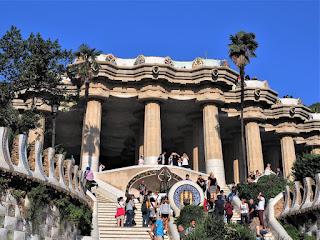














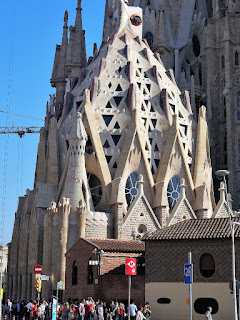





















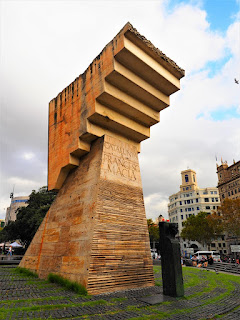





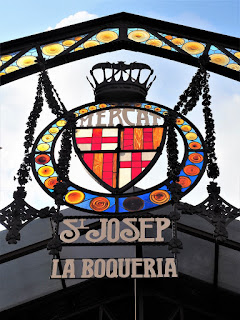



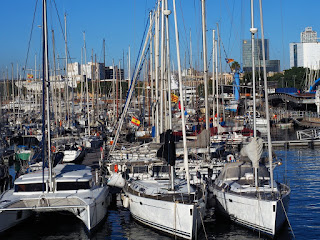






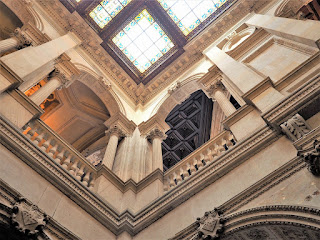












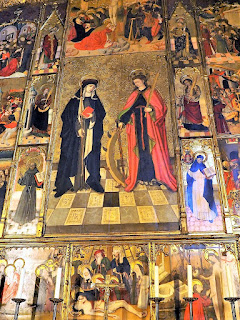
























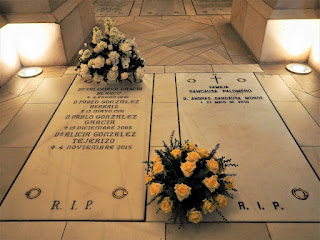










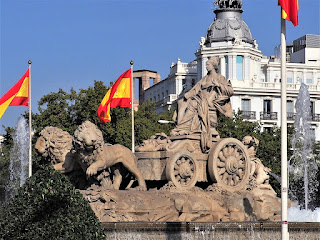












No comments:
Post a Comment